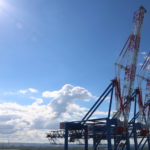While major North Range ports have to deal with decreasing container volumes,
the expansion of the Deepwater Container Terminal DCT Gdansk will soon
be completed. Growing volumes in the first half of 2016 look like
a good omen
The infrastructure works were finished in late August. »When it comes to such a large project it is normal that[ds_preview] successive elements are gradually becoming operational. While the infrastructure is almost ready, some of the equipment is still being erected, started and tested. The T2 opening ceremony is planned for October this year,« the terminal operator states. T2 terminal will be fully operational by the end of 2016.
Three ship-to-ship cranes have already arrived dismantled by sea in May at the construction site and have recently been erected and positioned on the crane rails. They were built by Liebherr in Killarney, Ireland, and Rockstock, Germany, and were transported on heavy-load carrier »Fremantle« via Fenit and Rostock to Gdansk. The STS cranes of T2 terminal with a height of 130m (boom up) and around 89m (boom down), with the outreach of 25 rows of containers will be able to handle the largest container vessels in the world (also see HANSA 2/2016).
While during the last year throughput figures of major North Range ports were affected by the sanctions against Russia as well as the Russian economic crisis and the slow down of the Chinese economy, the number of TEUs handled at DCT has increased again recently. 2015 was the first year with a decrease in container volumes for DCT, which had only seen steady growth since its inauguration in 2005. A 30% drop in transhipments to Russia had led to a 10% overall decline – from over 1.2mill. TEU handled in 2014 down to 1.09mill. TEU. However, new alliance customers had helped to absorb a big part of the losses. In the first half of last year, DCT handled 496,486TEU, but for the first six months of this year, 640,571TEU were reported. If the upward trend continues DCT could beat its 2014 record in 2016. Of the big North Range ports Antwerp reported a 4.4% increase in container volumes, Bremerhaven announced a 3.9% plus. The biggest player, Rotterdam, lost 2.3% in TEU and Hamburg 1.2% – mainly attributed to a decrease in transshipments to Polish and Swedish ports that see more and more direct calls of large container vessels (see also pages 176,177).
While Hamburg is also suffering from the sanctions against Russia, besides slow China business, DCT was often viewed as especially depending on transhipments to Russia. However, the strategy of the Terminal operator seems to work well even with a weak Russian economy although the container market in the Baltic region could not remain unaffected by the economic slowdown in Russia. »The majority of container terminals in the northern part of Europe noted a decline in TEU numbers. Indeed, the situation in DCT Gdansk looked pretty good in comparison with other terminals. In a changed environment, DCT diversified the portfolio of customers, which allowed ship owners to offer a range of new ocean and feeder connections,« explained Maciek Kwiatkowski, Chief Executive Officer of DCT. The Terminal attracted new ship owners in 2015, who in 2016 kept increasing their potential and continued to move cargo from the ports of Western Europe to Gda sk, Kwiatkowski continued and pointed out: »It is also worth noting that Polish economy is in good condition, confirmed by its current and forecast healthy GDP growth rates.«
The terminal operator states that every effort is made to provide the best service for the existing customers. Due to fact that the capacity of the terminal is going to be doubled DCT also wants to attract new ones. »Currently, three out of four container carrier alliances undergo restructuring. We continue to monitor this very dynamic situation among shipping lines while conducting negotiations with the majority of them,« the company stated. Until February 2015, Maersk Line was the only customer calling at DCT, then the 2M and G6 alliances joined.
Kwiatkowski commented: »DCT Gda sk ended the first six months of 2016 with a much higher volume than in the same period last year. The forecasts are very optimistic. We expect the containerized cargo to grow in the Baltic Sea Region. The second berth in DCT Gdansk will allow the terminal to meet the growing demand for deep-sea services in Central-Eastern Europe. Further development of DCT Gdansk will permanently change the face of Polish economy in this part of the world.«
Upon completion of T2 the combined annual throughput capacity of DCT will be 3mill.TEU with an annual rail siding capacity of 780,000TEU. Ships will be serviced at two 650m berths by eleven STS-cranes, 35 rubber tire gantry cranes will operate on the 76.2ha facility. Water depth at the quays is 17m.
Felix Selzer




















